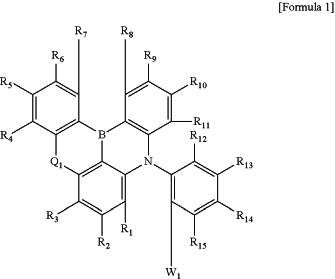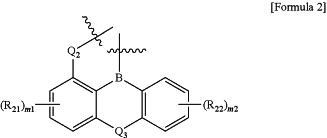| CPC H10K 85/6572 (2023.02) [H10K 85/40 (2023.02); H10K 85/636 (2023.02); H10K 85/6574 (2023.02); H10K 85/6576 (2023.02); H10K 50/11 (2023.02); H10K 2101/10 (2023.02)] | 20 Claims |
|
1. A light emitting device, comprising:
a first electrode;
a second electrode disposed on the first electrode; and
an emission layer disposed between the first electrode and the second electrode and comprising a polycyclic compound represented by Formula 1,
wherein the light emitting device has an external quantum efficiency in a range of about 20% to about 30%:
 wherein in Formula 1,
W1 is a substituted or unsubstituted carbazole group, a substituted or unsubstituted dibenzofuran group, or a substituted or unsubstituted dibenzothiophene group,
Q1 is NR16, O, or S, and
R1 to R16 are each independently a hydrogen atom, a deuterium atom, a halogen atom, a substituted or unsubstituted boryl group, a substituted or unsubstituted silyl group, a substituted or unsubstituted amine group, a substituted or unsubstituted alkyl group of 1 to 20 carbon atoms, a substituted or unsubstituted aryl group of 6 to 20 ring-forming carbon atoms, or a substituted or unsubstituted heteroaryl group of 2 to 20 ring-forming carbon atoms, or a group represented by Formula 2 is bonded to adjacent groups of R1 to R16:
 wherein in Formula 2,
Q2 and Q3 are each independently NR23, O, or S,
m1 is an integer from 1 to 3,
m2 is an integer from 1 to 4,
R21 to R23 are each independently a hydrogen atom, a deuterium atom, a halogen atom, a substituted or unsubstituted boryl group, a substituted or unsubstituted silyl group, a substituted or unsubstituted amine group, a substituted or unsubstituted alkyl group of 1 to 20 carbon atoms, a substituted or unsubstituted aryl group of 6 to 20 ring-forming carbon atoms, or a substituted or unsubstituted heteroaryl group of 2 to 20 ring-forming carbon atoms, and
 indicates a binding site to a neighboring atom.
|